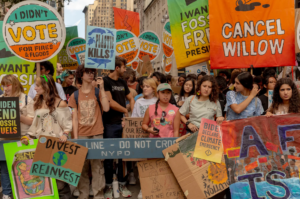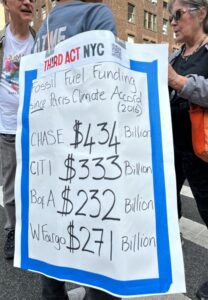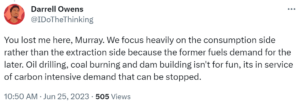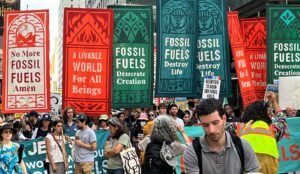Sunday’s March to End Fossil Fuels in midtown Manhattan was big, loud and vibrant. The organizers put the tally at 75,000. While that may have been over-generous, the march was far and away the largest U.S. climate assemblage in some time.
It was also an occasion to ponder the goals and tactics of the climate movement.
The customary signs and chants denouncing Big Oil and its funder banks were out in force. What felt new, and unsettling, was the vitriol directed at President Biden. Last year’s passage of the Inflation Reduction Act, with its promise to hasten the transition from fossil fuels by accelerating wind and solar and electrification, might as well have been an hallucination.

This photo by Sarah Blesener ran above the fold in the New York Times’ print edition the next day. The paper’s online caption caught the focus of the march: “Protest organizers used Sunday’s event to send a message to President Biden as he begins his push for re-election: Do more if you want our votes.”
Ganging Up On Joe
The signs and chants castigating the president flowed like a river. Biden: Declare a climate emergency … Cancel Willow … I didn’t vote for fires and floods.
Yikes. Whatever happened to the Inflation Reduction Act’s nearly half-a-trillion dollars worth of tax credits and other subsidies paying down the cost of renewable electricity from solar and wind farms while also cutting consumer costs to purchase electric vehicles, electric heat pumps, and home and commercial electric battery storage?
The intent of the IRA’s myriad and synergistic incentives isn’t just to grow the U.S. green manufacturing base with good-paying green jobs. It’s to displace fossil-fuel use by retiring petrol-fueled engines and furnaces and simultaneously “greening the grid” by speeding the rate at which wind and solar power usurp electricity generation from coal and methane gas.
As the IRA was snaking through Congress last August, energy analysts were scoping the potential carbon and methane reductions from those displacements, along with estimates of increased emissions from new federal oil and gas leasing that Biden committed to expedite to win the tie-breaking Yes vote from West Virginia Senator Joe Manchin. One leading think tank, Energy Innovation, concluded that “The bill’s clean energy measures will yield 24 times more emissions reductions than its fossil fuel provisions will increase emissions.” (The firm subsequently raised its 24-to-1 emissions ratio to 28-to-1.)
Seven months later, Biden held up his end of the deal, issuing a permit okaying ConocoPhillips’ $6 billion Willow oil-and-gas drilling venture on Alaska’s North Slope — and threw away the climate good will due him from the IRA. Never mind that the additional carbon emissions from the Biden-Willow “hydrocarbon bomb” will only negate a fraction of the emission reductions from his legislation’s clean electricity and end-use electrification, as I pointed out back in March. Even more poignantly, those additional emissions are more properly estimated to be close to zero. Why? Because what actually burns the carbon fuels and puts the CO2 into the atmosphere is fossil fuel consumption, not supply. If Biden had rejected Willow, the same supply would have been called forth from Nigeria, or Kuwait or some other oil region or state to fill U.S. cars, planes and trucks.
In other words, Willow or any new U.S. drilling activity is nearly irrelevant from a climate standpoint because, as we wrote then, “demand finds a way to create supply,” rather than the reverse.
As we marched, I asked a smattering of anti-Biden sign-holders if the president merited praise for the green energy unleashed by his IRA, rather than criticism for okaying Willow or the other contentious project, the Mountain Valley Pipeline through West Virginia. The typical response was No, we’re in a climate emergency. Any new fossil-fuel infrastructure is too much.
To be sure, trade-offs are hard to wrestle with even in calm moments, much less among a big crowd on the move. But the blank stares about the IRA and occasional flashes of venom against Biden were disquieting, nonetheless. The Times‘ headline for its print report on the march was all too accurate: “Fingers Pointed at President, Protesters Demand End to Fossil Fuels.” Left unsaid is whether protesting Biden climate bombs will seed electoral bombs in 2024, placing our democracy as well as climate in irredeemable peril.
Who’s Really Funding Fossil Fuels?
If the anti-Biden sentiment was novel, the anti-big banks rhetoric was old hat. Blaming the climate crisis on Big Oil and demanding that universities, pension funds and the like “divest” by dumping fossil fuel securities from their holdings, has been a staple of climate organizing for nearly a dozen years, as I decried a year-and-a-half ago, in Exxon doesn’t care if you divest. Neither does climate:
When the writer and climate activist Bill McKibben kicked off the [divestment] campaign in a July 2012 Rolling Stone article, Global Warming’s Terrifying New Math, the rationale was three-fold: (1) dry up capital and make it harder for the fossil fuel industry to create new mines, wells, pipelines and terminals; (2) weaken the industry’s social and political standing so it couldn’t easily block pro-climate policy; and (3) by hanging a “Dump Me” sign around Big Oil, amp up climate organizing. Not for nothing did McKibben subtitle his Rolling Stone article, “Make clear who the real enemy is.” It was Exxon and its brethren.

A climate marcher with Third Act helpfully displayed the biggest U.S. banks’ fossil-fuel financing over the past seven years.
That path has proven to be a dead-end, I concluded in my post. One piece of evidence was a simple graph showing that Exxon-Mobil’s share price had outperformed the stock market as a whole since the onset of the Covid pandemic. More evidence, if any were needed, was available in the wonderfully wonky signboard at left that was borne by one of yesterday’s marchers, a vibrant senior citizen affiliated with the McKibben-inspired Third Act.
The amounts that the four banks — Chase, Citi, Bank of America, and Wells Fargo — have funneled into fossil fuels since the start of 2016 sum to an impressive-seeming $1.27 trillion ($1,270,000,000,000). Yet over the same period, consumption of petroleum products by U.S. families and businesses earned the oil companies a revenue haul nearly three-and-a-half times as great: an estimated $4.29 trillion ($4,290,000,000,000).
[I calculated that figure from the average 19.9 million barrels per day of gasoline, diesel fuel, jet fuel and other petroleum products kerosene and so forth consumed per day over the same seven years, 2016-2022. (See Energy Information Administration, Monthly Energy Review, Table 3.5 Petroleum Products Supplied by Type.) Factoring in (1) there are 42 gallons of petrol per barrel, (2) the seven years total 2,555 days (365 x 7), and 3) an average retail price per gallon sold of $2.00 — a conservative markdown from the actual $2.82 average retail price of gasoline over that period — yields $4.29 trillion.]
Who’s really funding fossil fuels? American households, businesses and institutions, locked into grotesque consumption levels that U.S. climate activists studiously ignore.
To be sure, my dollar comparison has apples-and-oranges elements. Only some of the $4 trillion or more in petrol sales is available for investment in exploration and other petroleum infrastructure. And other banks beyond the Big Four also fund oil investment. On the other hand, U.S. consumption of methane gas and coal fossil fuels now exceeds consumption of petroleum on a Btu basis by 20 percent, suggesting that total fossil fuel revenues over the past six years was probably in the vicinity of $8 billion rather than the $4.3 billion from petroleum products alone.
My point is that bank financing is a much weaker linchpin for creating new fossil fuel infrastructure than most climate activists suppose. What really makes fossil supply possible is the lock-in of consumption of fossil fuels themselves, in billions of routine purchases that, day in and day out, fork over many more dollars to the fossil fuel industry than do the banks.

(Owens was responding to a Cameron Murray, PhD, who was decrying the idea of asking Americans to take some responsibility for their personal carbon footprint.)
Or, as Darrell Owens, an analyst with CA YIMBY (Yes In My Back Yard), the pro-housing group that has spearheaded the recent revolution of expansionary zoning in California, put it recently on Twitter, “Oil drilling [and such] isn’t for fun, it’s in service of carbon intensive demand that can be stopped.” Stopped how? By undoing automobile dependence, incentivizing smaller vehicles, densifying suburbia, introducing congestion and road pricing, and of course, federal-level carbon taxing, as I detailed last year for The Nation magazine (The Climate Movement In Its Own Way).
Uprooting the Source: Carbon Consumption
Happily, some at Sunday’s march saw past Biden and the banks and critiqued the structures of consumption that enforce dependence on fossil fuels, whether directly at the gas pump or the furnace or stove, or indirectly in purchases of products whose manufacture and transportation entail massive quantities of fuel, or in inefficient or indulgent use of electricity, most of which is still made by burning coal or methane gas.
These included stalwarts from Citizens Climate Lobby, including an enthusiastic contingent from Pittsburgh as well as folks from across the Northeast; and individuals whose handcrafted signs called out U.S. car culture not only for its gasoline profligacy but for its stifling of human life and health.

Some marchers saw beyond Biden and bankers to demand enduring solutions: carbon fee-and-dividend and liberation from automobiles.
“Tax Pollution, Pay People” packs so much into four words, I said to the sign-holder, a CCL member from Pittsburgh, who told me his name, which I failed to write down. When I told him mine, he nearly jumped out of his shoes and shouted it to his fellow CCL’ers as if I was Greta Thunberg and Steelers legend Franco Harris rolled into one.
I started to apologize for CTC’s relative quiescence over the past year or two and to explain that I’ve been consumed with helping get NYC’s congestion pricing plan across the goal line. He stopped me short, thanking me for CTC’s work and insisting that, together, we’ll win a nationwide price on carbon before it’s too late.
So there’s my take. Singling out Biden for attack felt excessive and worrisome, since any falloff in enthusiasm will crimp the chances of small-d democratic, climate-aware outcomes in the elections next year. Similarly, more than a decade’s worth of targeting Big Oil and the banks doesn’t appear to have moved the needle for effective climate policy. Going after “luxury carbon,” as Extinction Rebellion did in a small but resonant climate action last week that I helped organize, feels to me like a more empowering path, one that might capture both the populist moment and climate urgency in a single stroke.
But notwithstanding the mis-directions, it was uplifting to be amidst tens of thousands with a like mind: A better world is possible. A better world is necessary. I want a fossil-free president. Amen to that!


Sean John says
If you had asked me at the march, I would’ve said that the IRA is really great in an easy, capitalist way. It’s sort of like how the marketing for the 3Rs, recycling reducing reusing, dwindled down to just the recycling part over the years because it was the only one they could make money from, even though it probably makes the least impact due to the recycling process. The IRA gives an incentive for an individual to buy more things, but just like turning off lights and unplugging things, individual acts won’t make an impact on the climate, even if everyone did it. Hybrid and electric cars are great, but if they are created by using fossil fuel, the life of that car won’t beat out the amount of ecological damage it took to create it. People need to stop being persuaded to buy new things. It’s not sexy, but buying a used car actually makes less of an ecological impact. All new cars should be electric, AND as we phase out gas, we should be using the cars we already have. I’m not against the IRA, but the idea that the solution is everyone should be incentivized to buy the newest thing and discard the old is wasteful and actually makes things worse. This concept is a product of a capitalist thinking that really doesn’t want to deviate from the status quo, and deviating from the status quo is critical to actually moving the needle on climate change. The IRA is a relatively easy political move that says “don’t say we never did nothing!” Both sides like rebates and tax deductions – it’s not that controversial of an Act.
No, if Biden wanted to make an actual impact, and show a true commitment to the cause, he would stop approving permits for pipelines, take an active stance against subsidizing the industry, and oppose building new fossil fuel power plants. But he hasn’t and that’s why protestors are correctly going at him in the face a U.N. summit that is supposed to make a global agreement on phasing out fossil fuel. The U.S. needs to be a solid player in this U.N. agreement, but with a U.S. president who consistently still approves fossil fuel permits, the success of the summit doesn’t bode well for the climate. Thus we need to push him to finally take a solid position against fossil fuel.
The common age-old criticisms on progressive activists that you shouldn’t be critical of the Democrat president, because that could hurt the next election is laughable. So we should just fully back an elected official no matter what they do, just because they are labeled as a democrat? I don’t care how many Trumps there are – a democratic system relies on The People to hold ALL their electeds accountable. Lumping in another age-old wonky piece of wisdom made in this article – we should let them do it here, because if we don’t, they’ll just do it somewhere else (or “demand finds a way to create supply”). That could be applied to just about anything anywhere. So we should let anything that’s bad happen because it will probably happen anyway somewhere else? What is that? No we fight the battle where we can, and then fight the next battle and/or pass broad stroking measures that limit the practice entirely. The lucky thing about this issue is the source of electricity can be interchanged. No one has to go abroad to get oil if you can get electricity from renewables here. There are other ways you can get the supply now.
Lorna Salzman says
The three recommendations to Biden above are sane and sound. I agree. No leader, candidate or not, should get our support or praise wthout enacting them. No compromise, was what the late Dave Foreman said. No half measures. No deals. No funding. No subsidies. No new plants. No more drilling. Uncompromising leadership.
John Gage says
As Cath McKenna says, the messaging is critical. Pollution should not be free, and people come out ahead when we give them the money collected from a carbon producer polluters fee. I attend climate events and protests to share the message with the people who show up: learn about the pollution-reducing power and fairness of Carbon Fee and Dividend and add advocating for it to your list of climate actions. Join CCL to learn easy ways to do it. Students can lead a cfdmovement.com project at their school. “Explicit carbon prices remain a necessary condition of ambitious climate policies” – IPCC SR15. There are some some CFD resources at bit.ly/cfdresources.